
|   |

|   |
 e-mail: sunilkothari1933@gmail.com 36th Kinkini Nrithyotsava Photos: Aashrith Mallur February 20, 2020 Kinkini institution was established in 1983 in Bangalore by N.R. Ganapathy and Yamuna Ganapathy to promote, propagate and popularize classical dances. They hold the position of the President and Secretary of the institution respectively. Among their children, their daughter Bharatanatyam exponent Rangashree has been very active since 1986 undertaking several activities relating to training young generation of dancers in Bharatanatyam and Yoga. She is the artistic director of Kinkini. Kinkini has been organizing dance festivals in Bangalore for past 36 years featuring national level celebrated artists in tandem with young upcoming dancers. Kinkini has a branch in Kuwait, so Rangashree divides her time between Kuwait and Bangalore. Kinkini is the only institution which has been conferred with Karnataka Kalashree award for its distinctive services in 2014. This year, Rangashree curated the festival presenting duets in different styles in the first half of the festival, followed by duets in Bharatanatyam. The five day festival from 25th till 29th January included Kuchipudi, Odissi, Kathak, Kathakali and Mohiniattam in the first half and Bharatanatyam duets in the second half. I could attend the festival from 27th January for three days. The artists who participated on 25th were Kuchipudi Guru Jayarama Rao and his disciple T. Reddy Lakshmi from New Delhi, and in Bharatanatyam, Sathyanarayana Raju and Saundarya Srivatsa. I was told that on account of indisposed health of Saundarya, they presented solo numbers. On 26th Madhulita Mohapatra and Pankaj Kumar Pradhan presented Odissi followed by Vijna Vasudevan and Renjith Babu in Bharatanatyam. 27th January 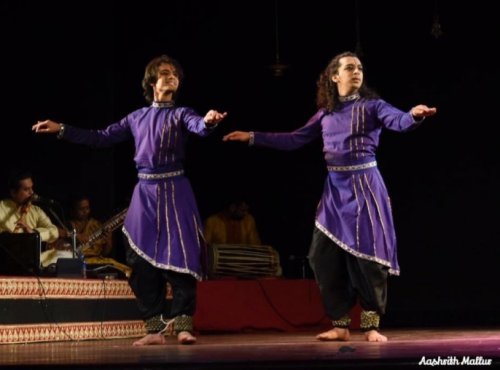 Sharath & Bharath Prabhath Sons of Acharya Raghavendra J Prabhath, a traditional Harikatha artist, Sharath and Bharath presented a duet in Kathak. They received early training in Kathak under Nirupama and Rajendra. Currently they are learning Kathak under Jaipur gharana maestro Rajendra Gangani. Recently during Drishti National Dance Festival, I had seen Sharath's performance as a Harikatha artist in role of a Sutradhara. He is also well versed in classical music and dance. Both the brothers have inherited the art traditionally and have been active on the scene choreographing dance-dramas. They opened their recital with Ganesh stuti describing the attributes of Lord Ganapati with Jaipur gharana bandish Gam Gam Ganapati, along with Marathi Abhang by Devaki Pandit, in Rageshri and teen taal, 'Pahilya gananam ghyanadeva mahne'. The stanzas were interspersed with tode, tukde, bols dhan dha tackit dha, and taking chakkars, 'Layabadha shabdas' putting on ankle bells which produce rinu jhinu sounds. Both the dancers executed footwork invoking the form of Ganapati vividly. It was followed by Ashtamangal tala of 11 beats time cycle, exploring the rhythmic permutations and combinations. It consisted of tukdas, todes, tihais, parans, parmelu, chakkardhar, gat bhav, ladis .The variety was representative of the intensive training they are receiving. An interesting Kavit 'Mundan par nachat Giridhari', Krishna dancing on the hood of Kaliya, was performed by Sharath competently. However, he explained that the bols on parmelu kuku tari etc., he has put in form of telling the story of demon Maricha who takes form of golden deer and entices Sita. While the attempt is welcome, its execution did not meet with Kathak 'ang,' the bodily movements and veered on form a la Bharatanatyam. The brothers will have to guard against that as the preponderance of the South Indian style appears incongruent in suggestive Kathak abhinaya. Shiva stuti choreographed by Guru Maya Rao in Malkauns raga and chautala, as a part of the presentation was executed vigorously by Bharath Prabhath. The kavit 'Nachat Shankar, bhal trinetra, bhasma bhushita ang, shir par Ganga', and taking rounds on floor on knees, as seen in Yakshagana, were performed spiritedly. Similar movements are performed in Rasalila also. However, the final poses lacked the finesse and holding arms diagonally, did not emerge smoothly as they should in Kathak and looked like splicing the air. Both the dancers will have to work hard on this aspect. What is known in Kathak parlance as 'ang', bodily postures and grace, have to be mastered. Sharath presented a composition by Acharya Raghavendra in Kannada in form of a ghazal, which he has choreographed. Sharath at the age of 14 had composed the music for the same with Rohith. The composition dealt with the similarities between nature and a woman. The nayak invites his beloved to spend time with him, accompany him in an evening walk, listen to cuckoo, sing and totally get immersed in love. To suggest shringara and shyness on part of the nayika, Sharath used variety of ghunghats as seen in Kathak, image of Kamadeva shooting flowery arrows; during lightning and after rain, he performed Mayur ki gat, dancing like a peacock; for rain he used footwork using various Kathak elements. When the nayak compared the beauty of the nayika that even the moon pales in comparison, her speech was more beautiful than pearls and so on, the images were drawn well. Whereas the spirit of the ghazal for romance is captured in Kannada song, the execution often veered towards abhinaya as seen in South Indian dance form. There are rough edges which need to be smoothened. They concluded their performance with Tarana in Carnatic raga Sriranjani and Carnatic frame work. The music and choreography were by Sharath Prabhath. It was interesting to have Carnatic flavour, but the enjoyment is enhanced with the flavour of Hindustani raga as tarana needs to stand out as Kathak tarana even when there are common elements between Tillana and Tarana. Part of it was interspersed with tode, tukde, tatkar to distinguish it from Tillana. There was an array of excellent accompanists. Vocal - Siddharth Belamannu, padhant - Divya Gokhale, tabla - Jagdeesh Kurtkoti, pakhavaj - Prabodh Shyam Anoor, sitar - Shruti Kamat, harmonium - Sattvika Chakravarthy and flute - Bharath Athreya.  Anil Iyer & Lavanthi S. Kumar Poornima Gururaja's disciples Anil Iyer and Lavanthi S. Kumar presented Bharatanatyam duet. They have received sound training from their guru as was evident in their nritta. They presented Thyagaraja Ashtakam under the title Thyagaraja Vaibhava. It dwelt upon the greatness of Thyagaraja, interpreted as king of sacrifices, and is a form of Shiva worshipped in Thiruvarur. Both the dancers offered salutations to Thyagaraja, eulogizing his divine qualities, one who is a great teacher, a storehouse of knowledge and auspiciousness. The dancers presented Mohamana varnam of Tanjore Quartet in raga Bhairavi and tala adi. The interesting part was the two dancers at times repeated through abhinaya the sentiments of a nayika in love with Thyagesha, beseeching his blessings and asking why he, the Lord was indifferent to her. It was interesting to watch Anil taking role of Lord Shiva and Lavanthi that of nayika. Then both as devotees danced together. The nritta part was well synchronized. Their lines were clear and they maintained symmetry. The description of the city with its magnificent architecture, pillars adorned with sculptures, the procession of the lord with musicians performing in front, the drummers, the nadaswaram players, the dancers dancing et al were enacted graphically. Reliving the wonderful moments spent together, the nayika begs of the Lord to come closer and embrace her. She speaks of the agony of remaining away as even a moment separated was like an eon. Manmatha's arrows pierce her. The choreography stood out for imaginative approach using two dancers in a duet. There were interesting references to the lord's greatness. The nayika requests the Lord, who resides in Kailasa, to show compassion towards her. A pallavi from Thyagaraja's Yoga Vaibhavam, was adapted for dance. Set to Ananda Bhairavi raga and tala adi, the composition of Muthuswami Dikshitar aims at the elevation of state from mundane to spiritual. It dealt with various sancharis with Lord Shiva protecting one who seeks his help, like Markandeya prayed to Lord Shiva and clung to him in form of Linga; the Lord kicked Yama, who had come to take away his life. Lord Shiva protects equally the devas and manavas. Interesting sancharis were performed when monkey faced king Muchukunda helps Indra win the war and on being offered a boon, Muchukunda asks for the original Somaskanda murthy, which rests on the chest of Lord Vishnu. Indra not willing to give it away creates six identical ones to the original and demands of Muchukunda to recognize the original one and if he succeeds he will be allowed to take original one and he brings it down to Thiruvarur. Ajapa natanam was also mentioned. It is considered dance of Thiruvarur Thyagesha. Thyagesha rests on Vishnu's chest before being brought down to earth. Vishnu's breath then becomes the cosmic dance of Shiva resembling the prancing of a goat, meaning aja. The dancers concluded with Gauri Nayaka Tillana, a composition of Mahavaidyanatha Bhagavathar, set to raga Kanada and tala adi. It began with a shloka describing the form of Shiva as Trishuladhari, wearing the hide of elephant, performing Ananda natanam. The joyous mood of tillana was evident and the covering of the space with periya adavu was executed with finesse. The musicians were Poornima Gururaja on nattuvangam, S. Srivatsa on vocal, Srihari Rangaswamy on mridangam, Natarajamurthy on violin and Narasimhamurthy on flute. 28th January 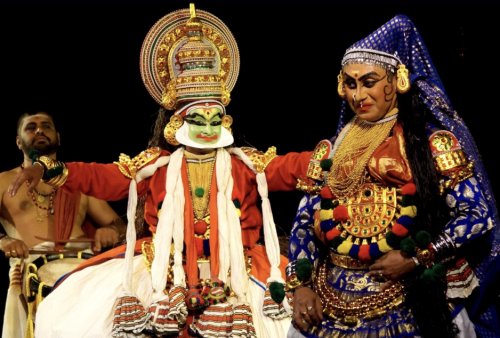 Sadanam Vipin Chandran & Prabal Gupta The evening opened with traditional Kathakali musical interlude by two vocalists, maddalam and chenda players, transporting all to the temple courtyard of Kerala. Prabal Gupta, the noted Bangalore based Kathakali exponent along with Sadanam Vipin Chandran, presented Purappad executing excellent Kalasams, with attractive articulation of the body to various talas including champada and set to Ragamalika. Prabal had selected the excerpt from Narakasuravadham of Karthika Thirunal in which demon Nakratundi attempts to attract Jayanthan, son of Indra, as she is infatuated by his valour and majestic looks. In the streevesham known as Lalita, Prabal has acquired mastery with subtle netrabhinaya. I have mentioned in my recent review of his performance in role of Urvashi who gets infatuated by handsome Arjuna. But to the credit of Prabal, I must say that he invested the character of Nakratundi with different approach as she is a demon. The lust she displays, the arrows of Kamadeva, which increase her passion and the way she begs Jayanthan to fulfill her desire, were performed with artistry separating the character of celestial Urvashi and demon Nakratundi. Vipin Chandran as Jayanthan wielding sword is shocked at Nakratundi's advances and rejects her. Finally Nakratundi attempts to embrace Jayanthan who escapes her and when she reveals her demonic form wearing her long black stresses in her teeth, Jayanthan cuts her nose with his sword and a shrieking Nakratundi runs away into the wing. The entire episode is full of drama. Vipin Chandran acts with majestic demeanour and Prabal with his natural assets of large eyes registers erotic nuances that capture the audience's attention. The musicians gave customary support to the dancers - vocal by Sadanam Sivadas and Sadanam Jyothish Babu, chenda and edakka by Sadanam Ramakrishnan, maddalam by Kalamandalam Prasanth Atoor, Chutti make up by Kalamandalam Sathish Kumar and support by Anil Kumar. 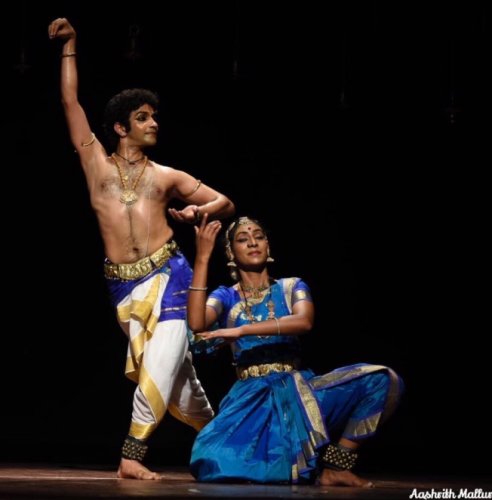 Pavitra Bhat & Aparna Shastry The husband and wife duo of Pavitra Bhat and Aparna Shastry presented varnam in Charukesi and tala adi, a composition of Srivatsa. Pavitra is a disciple of Guru Deepak Majumdar and has made a name as an excellent Bharatanatyam dancer among his contemporaries. Aparna was trained by Bangalore based guru Radha Sridhar. Both of them make a handsome pair. Their performances are noted for their command over technique and scintillating nritta. The jatis composed by Kadirvelu have a sparkling quality that enhances the beauty of nritta. Sumukha Gajamukha Vinayaka was replete with several stories of Ganesha. Parvati from her own being created the divine child and was delighted to have him. One day she went to take bath, asking the child not to let anyone enter. Lord Shiva arrived astride Nandi and the child refuses to let him enter. Shiva got angry and in duel with the child, cut off his head. On learning that it was born out of Parvati, he sent his servant to get hold of the first being's head to replace on the child's body. The child with head of elephant came to be known as Ganesha. Once Parvati offered sweet with a condition that between Kartikeya and Ganesha whoever returns first after circling the universe three times would get it. Kartikeya mocked at Ganapati as he had the vehicle of a mouse and Kartikeya had peacock that can fly round the world. Clever Ganesha considered the parents as the universe and on his mouse took three rounds and arrived before Kartikeya, and received the sweet from his parents. Lord Ganesha is always remembered. Even in Vyasa's Mahabharata, Lord Ganesha is invited by Vyasa to write the Mahabharata story as he narrates. The references to Krishna's role as Parthasarathi, giving him courage to fight, taking the vishwaroopa were enacted in interesting manner. Pavitra selected a Suradas bhajan requesting Krishna to give him antardrishti (inner vision) as he was blind. 'Hey Govinda, hey Gopala, aba to jiwan hare' - Krishna saves his devotees when they pray to him. The waves of Yamuna, the movement of Gajaraja waving his trunk, trying to release his leg from the mouth of the crocodile and Krishna's arriving in time were projected dramatically by Pavitra. Praying to Krishna as Nandaraja's son, Suradas says, "I have surrendered at your feet and you will help me cross the ocean of life." They are bright stars of Bharatanatyam with quite a spark in their dance and an ability to express emotions. Both have emerged as front liners from the younger generation. They were accompanied on nattuvangam by D. V. Prasanna, vocal by Raghuram, mridangam by Lingaraju and flute by Vivek Krishna. 29th January 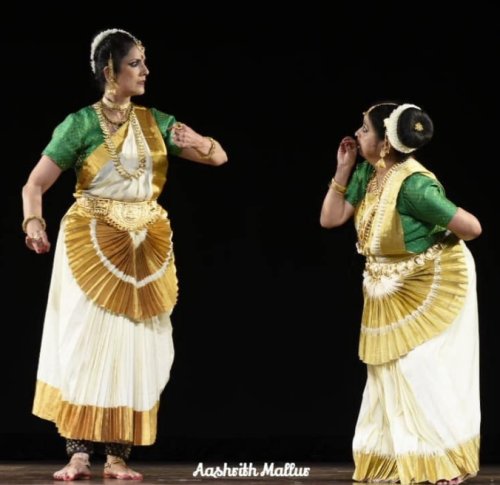 Sreedevi Unni & Shanti Menon Senior exponent of Mohiniattam, Sreedevi Unni and her disciple Shanti Menon opened the evening. They offered prayer to Lord Ganapati who is remover of all obstacles and a darling son of Shiva and Parvati. The composition of Kavalam Narayana Panicker was included in their performance. It eulogizes Lord Ganapati's greatness. The other prayer was to Goddess who takes several forms, offering pranams to Goddess Saraswati, whose blessings the devotees seek. Set to raga Arabhi, the devotees praise Parvatha Nandini, who rides the lion. The iconic images were created by the dancers with the hastas used in typical graceful movements of Mohiniattam. Mohiniattam dancers are inspired to choreograph ashtapadis from Jayadeva's Gita Govinda kavya. This immortal 12th century classic gives dancers scope for portraying Radha's various states as a nayika. The ashtapadi Lalita lavanaga lata parishilana set to Vasanta raga, shows Radha in a state of separation and dejection, as Krishna is playing rasalila with other gopis. Seeing her state, the sakhi tells her to get up and join Krishna who is dancing with gopis on the banks of Yamuna. The spring season is in full bloom. The gentle breeze has made the creepers more fragrant with the scent of clove, the birds are also dancing, the bees are hovering over flowers, the cuckoo bird is singing, and Krishna is dancing; at such a times why are you, O Radha, sitting alone and weeping? Sakhi cajoles Radha to get up and come with her to be united with Krishna. Shanti Menon also enacted the final stanza mentioning the poet's writing the song dealing with 'kamakeli,' love play between Radha and Krishna. Many choreographers do not perform these lines in order to leave the situation as it is. Shanti has an attractive stage presence. She wore the expressions well and her nritta was leisurely. In Swathi Thirunal's padam, Sreedevi Unni depicted the indifference the Lord shows to the nayika. The agonized nayika tells her sakhi to take her message to Lord Padmanabha; why is he ignoring her, has he forgotten those fun filled days? She decorates herself with ornaments in anticipation of her lord's arrival, looking in various directions. Sreedevi used minimum hand gestures and her abhinaya was restrained. She performed in a manner becoming her age. The major item Navarasa based on Ramayana shloka 'Shringaram kshitinandini viharane' elaborated upon the nine rasas. The incidents from Ramayana were chosen for each rasa. Shringara, love when Sita and her sakhi are playing with a ball in a garden and Rama passes through. Their eyes meet and love springs between Rama and Sita. Veera is shown when at Sita's swayamvara, Rama picks up the bow with his valour. There is a variation for Karunya, compassion. The original shloka mentions Karunyam Bali bhojane, when Kakasura demon attacked Sita's breast, when Rama was reclining on her lap. Rama turned Kakasura into ashes and Sita wants Rama to show compassion to the demon. Sreedevi interpreted Jatayu, whose wings were cut off by Ravana and seeing him wounded, Rama is moved to compassion. Hasyam is generated when Soorpanakha in disguise of beautiful woman makes advances to Rama to marry her. Sreedevi appropriately runs hither thither between Rama and Lakshmana and Rama finds it comic. In original shloka for Bhayam, it states that Rama is afraid when something unholy has to be committed - 'Bhayam aghe'. Sreedevi interpreted Sita as being afraid as Soorpanakha approaches her and instills fear in her. Adbhutam, wonderment was shown when the monkeys built the bridge on ocean throwing stones. Both Shanti and Sreedevi's enactment as monkeys made a fine combination of wonderment and hasyam. For Bibhatsa, Sreedevi chose incident of Soorpanakha again. When Lakshmana chops off Soorpanakha's nose, looking at the sight he feels revulsion. The original shloka mentions 'Bibhatsam anyamukhe'; being ekapatnivrata, devoted to one wife, Rama experiences revulsion looking at other women. 'Raudram Ravana mardane' also had different interpretation. When Ravana watches Hanuman being seated on higher plane on the coils of his own tail, he gets angry and challenges Hanuman on how dare he be on a higher level than him. I think the feeling of Raudram becomes the situation when Rama in a battle kills Ravana. Shantam was shown with meditation for the lord. Sreedevi Unni is a versatile exponent and enacted mature abhinaya. Shanti Menon performed with more energetic movements. The musical accompaniment was given by the musicians as follows: Vocal by Sudev Warier from Chennai, nattuvangam by Anita Peter, mridangam by Narayanaswamy, flute by Narasimhamurthy, veena by Shankar Raman, edakka by Kalamandalam Achutha Marar and maddalam by Kalamandalam Sreejith. 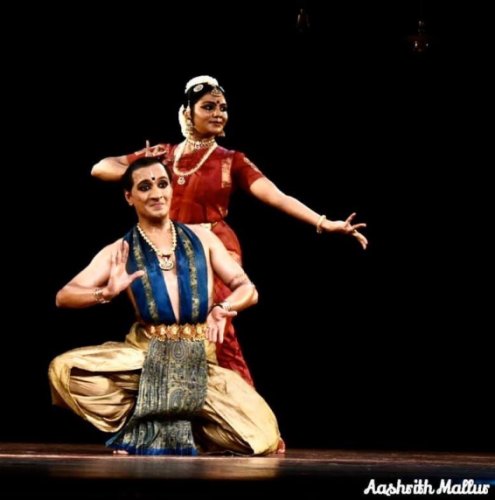 Srikanth & Aswathy Srikanth hails from Melattur village in Tanjore District, well known for Bhagavata Mela Natakam tradition. In an all male performers dance tradition, some of whom played female roles also, Srikanth has enacted roles of Sita and Devaki and won accolades for female impersonation. He is married to Aswathy, daughter of well known Malayalam writer M.T Vasudevan Nair and Kalamandalam Saraswathy. Aswathy has studied Mohiniattam, Kuchipudi and Bharatanatyam under her mother from a young age. Both have received critical appreciation for their duet performances. They presented Purandardasa's Gajavadana beduve in raga Hamsadhwani. It describes the beauty of the elephant headed god with Paasha and Ankusha, with Mushika as his vehicle. He showers his blessings on all those who worship him. The birth of Ganesha, Shiva's cutting off his head unknowingly, replacing elephant's head is well known and was performed with elan. The couple chose to present a varnam of Dr. Balamuralikrishna set to Gambheera Nattai ragam and tala adi. The poet eulogizes the Mother Goddess, giver of knowledge, wealth and courage. She is described as Akaara ukaara makaara rupini. It was interesting to note that each one took up the stanza and developed in sanchari to narrate the story which enhances the blessing of the goddess. Srikanth took up the story of how a mere woodcutter, a simpleton became the great Mahakavi Kalidasa with the blessings of the goddess. He was blessed with knowledge and wealth and became a well known poet. Both Srikanth and Aswathy displayed their command over pure dance showing clean lines, geometric patterns, dividing stage space in diagonal manner and executing exacting teermanams. In anupallavi, Aswathy enacted the story of Abhirami Bhattar. Offering flowers and praying, she was totally immersed. The king wondered at this unknown devotee and questioned her as to who she was. He watched her praying to the goddess. While worshipping, Abhirami committed a blunder thinking it was a full moon day, while it was a new moon day. The king got enraged and ordered her to be punished. Abhirami prayed to the goddess who in order to save her threw her earring and the moon shone like full moon. Thus the goddess saved her devotee and also the priest was saved from the king's wrath. The nritta was scintillating and even in fast tempo the clarity was maintained and the teermanams were perfectly executed. The couple stood out for their excellence of their chosen dance form. Gopalakrishna Bharati's Tamil padam Kaaranam kettu vaadi set to Poorvi Kalyani raga deals with the love between the nayika and her beloved lord of Chidambaram. He has not come to see her, therefore the nayika implores her sakhi to go to him and find out the reason for his delay. She recalls that her lord is an epitome of mercy; he took the form of a mid-wife, and helped a pregnant woman to deliver her baby when she was in trouble. When her lord has helped people in distress, how come he is not coming? Has she wronged him in any way? The vatsalya bhava was performed by Aswathy with intensity and mature abhinaya. In the finale, Srikanth took up the popular Kannada padam of Purandaradasa in raga Tilang. It had very good response since it is a shared tradition and the Kannadigas are familiar with it. Krishna tells his mother that he will behave from now on and will not disobey her. Mother Yashoda warns him that if he misbehaves, she will call Gumma, a strong man, who will take him away. Krishna says he will sit in one place and will not run around. He will not break pots of Gopis or play pranks, stealthily go into their house and steal butter, or when a gopi is asleep he will not tie her plait with the moustache of her husband. He will not drive away the calf when it is suckling its mother, nor would he milk the udder of the cow and directly drink the milk, he will not go to river Yamuna or jump into the water and disturb Kaliya, he will not ask for food and harass her. He would sit quietly. Mother Yashoda is overcome with love for Krishna at his confessions, and embraces him. She puts him to sleep in the cradle, covers him and gently walks away, but she notices her ankle bells making sound. Srikanth literally sits down on the floor, removes the ankle bells and takes them in his hands and tells Krishna's friends that they may go away, he is now asleep. That was a brilliant touch. Srikanth and Aswathy concluded the program with Mangalam. The musicians who gave them support were Nikhil Raveendran on nattuvangam, Murali Sangeetha on vocal, Jayaram on flute and Lingaraju on mridangam. The 36th edition of Kinkini Dance festival thus ended on an interesting note. Rangashree announced the 37th Annual Dance Festival for next year giving the dates as 23rd to 27th January 2021.  Dr. Sunil Kothari is a dance historian, scholar, author and critic, Padma Shri awardee and fellow, Sangeet Natak Akademi. Dance Critics' Association, New York, has honoured him with Lifetime Achievement award. Post your comments Please provide your name and email id when you use the Anonymous profile in the blog to post a comment. All appropriate comments posted with name and email id in the blog will also be featured in the site. |